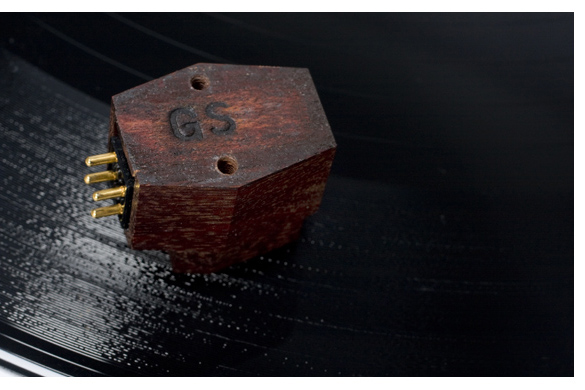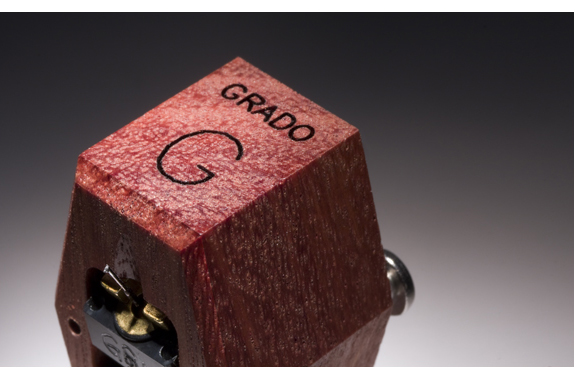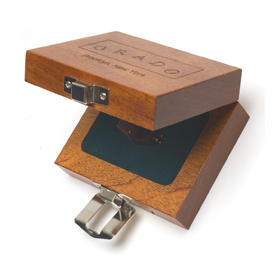Grado Statement 1
Grado Labs has always offered a great alternative to moving-coil cartridge technology with their moving-iron cartridge design, a cross between the moving coil and moving magnet design. Other than The Soundsmith, Grado is the only company still producing moving-iron cartridges in quantity, and they have refined their process to perfection.
Their new flagship, the Statement 1, replaces the Statement at the top of their product line, and the price has risen from $2,500 to $3,000. While this is a far reach from the budget Grado cartridges that many audiophiles are familiar with, in the day of $15,000 Koetsu’s and the Goldfinger tipping the scale around $12,000, a $3,000 top-of-the-line cartridge is still considered reasonable by many serious vinyl aficionados.
If you are new to the vinyl game and haven’t heard of Grado, or perhaps you only know about them from the world of headphones, meet John Grado, president of the company started by his uncle, Joe Grado, just over 50 years ago. And in case you didn’t know, Joe Grado is acknowledged as the inventor of the stereo moving-coil cartridge. Interestingly enough, Joe Grado was originally a watchmaker by trade, so he was quite familiar with working on a very small scale before he turned his attention to building phono cartridges.
Grado makes one of the widest ranges of phono cartridges available today, starting with the Grado Black for $60 all the way up to the Statement 1 that we’re looking at here. All Grado’s products are handmade in their Brooklyn factory and their wooden cartridge bodies are all made from Jarrah wood, a renewable resource.
First, the past
All cartridges have somewhat of a “signature sound” and the Grados are no different, possessing a slight to moderately warm tonal balance. For those who don’t approve of this reference, you might consider a Grado cartridge to be richer or full-bodied. One thing is certain, you will not mistake vinyl playback with a Grado cartridge for digital. Considering how many records have been poorly mastered, and how many new LP’s are produced from digital files, I personally think a few drops of warmth goes a long way toward making analog more palatable. As you go up the line with Grado wood-body cartridges, they all look the same, but each model progressively reveals more music.
My past experience with the original Statement has always been great, though that model has some limitations. While the original Statement can be too much of a good thing on certain records, it was also slightly limited in its ability to track complex musical passages with the ease that I’ve come to expect from my other cartridges made by Dynavector, Lyra and even Koetsu. The more of an analog maniac you become, the less chance you have of achieving a “one size fits all” solution to playback.
The Statement 1, just like the Statement before it, requires 47k phono loading, but because of the moving-iron design, Grado claims that is it relatively impervious to changes in input capacitance. A brief experiment with the original Statement, combined with the McIntosh C500 preamplifier (which allows capacitance loading to be made from the front panel) and the current cartridge confirm this.
However, because the Statement 1 has an output of only .5mv, you will still need a phono preamplifier or phono stage capable of fairly high gain.
 A quantum leap
A quantum leap
The new Statement 1 is miles ahead of the cartridge it replaces in two major areas: trackability and frequency extension, particularly at the upper frequency limit. The best news is that the current model has lost none of the midrange magic of the original, but it has gained additional purity and airiness that none of the other cartridges in the Grado line possess. Grado mentions a new special ellipsoid diamond stylus profile and seven feet of gold wire for the coils, so while the new cartridge looks virtually identical to the original Statement, it is essentially new from the ground up.
Fortunately, I had my original Statement here for comparison and after mounting both cartridges on identical SME 309 arms for side-by-side playback on the TW Acustic Raven TWO, it was easy to tell the two apart. I was also able to make some comparisons to the Koetsu Urushi Blue, the Clearaudio DaVinci and the Lyra Skala cartridges – all somewhat in the price range of the Statement 1. While all side-by-side listening comparisons were done with the Audio Research REF Phono 2, now my reference phono preamplifier, I did use the Statement 1 with a handful of other phono preamplifiers as well: the new Audio Research PH6, which is in the middle of review listening, as well as the Burmester 100 and the new AVID Pulsare. All were an excellent match with the Grado.
The Statement 1 did not need terribly long to break in; it sounded great right out of the box. After a few album sides, it loosened up a bit and by the end of a full day’s worth of LP playback, it was in its groove rather nicely. There was no noticeable change between the 50-hour mark and the 300-hour mark, so this is a cartridge that gets down to business right away.
Defining the sound
This is such a different cartridge from the one that it replaces that I wasn’t quite sure where to start the comparisons. One of the first records that I listened to critically was Brand X’s Moroccan Roll. The last track on the first side, “Collapsar,” opens with a driving fretless-bass riff that collides with drums and percussion. This track a relatively dense musical passage cut near the center of the record, has everything going against it. Where the original Statement struggled, the Statement 1 just glides right through effortlessly, keeping everything in the mix as it should be, in its own space. Another favorite inner-groove torture track is “Jericho” from Joni Mitchell’s Don Juan’s Reckless Daughter. Mitchell’s vocal is recorded hot, and lesser cartridges stumble here. Again, the Statement 1 passed through this track effortlessly. When changing musical style to hard rock, the Statement 1 did a flawless job with the 12-inch, 45-rpm single of AC/DC’s “Let’s Get It Up.” Brian Johnson’s voice was out in front of the wall of Marshall amps, with the backing vocals coming through loud and clear instead of getting lost in the mix.
Trackability is an important part of the analog mix, but it’s not everything. When playing the new Statement alongside the old, the increased dynamic capabilities of the new cartridge is much better, in a full-scale sense as well as its ability to reproduce fine detail. No matter what kind of music you favor, you will notice that the Statement 1 has a sufficiently weighty presentation to play your favorite large-scale orchestral pieces as well as capture the most subtle vocal nuances, which is a tough balancing act to pull off.
Finally, this cartridge has a tonality that will woo all but the coldest of hearts. As mentioned at the beginning of the review, the Statement 1 definitely has a full-bodied sound. But thanks to greater extension at both ends of the frequency range, acoustic instruments sound more lifelike than ever. On many levels, the new Statement 1 “out Koetsu’s” my Koetsu Urushi Blue, having all the warmth while adding more definition to the mix.
 Listening to the differences between the plucky guitar style of Michael Hedges and Alex DeGrassi on their early Windham Hill releases was a treat, with the resonant qualities of their instruments coming through in a more distinct way than I had heard before. The extra dynamic capability of the new model also did well with piano and violin, again keeping the core tonality intact, with decay that faded ever so gently into the blackness.
Listening to the differences between the plucky guitar style of Michael Hedges and Alex DeGrassi on their early Windham Hill releases was a treat, with the resonant qualities of their instruments coming through in a more distinct way than I had heard before. The extra dynamic capability of the new model also did well with piano and violin, again keeping the core tonality intact, with decay that faded ever so gently into the blackness.
Equally important is the huge, three-dimensional soundfield that this cartridge is able to reconstruct in your listening room. Just as the Statement before it was a glorious match with the ARC REF Phono 2, the Statement 1 enlarges the presentation in all dimensions. While we all know that pinpoint imaging in a three-dimensional space is not really an accurate reproduction of music, rock fans will easily become addicted by the way this cartridge really does place things distinctly across the soundstage.
 In the end, balance
In the end, balance
In summary, the greatest virtue of the Grado Statement 1 is its balance of all aspects of analog reproduction. There are a few (more-expensive) cartridges on the market that will perform any of the individual tasks better, but I challenge you to find a $3,000 cartridge that does this well handling everything. While I am fortunate to have this cartridge in my reference arsenal, if I were going to live with just one phono cartridge, the Grado Statement 1 would be it. Highly suggested.
The Grado Statement 1
MSRP: $3,000
www.gradolabs.com
Peripherals
Phono Preamplifiers ARC REF 2 Phono, ARC PH6 AVID Pulsare, Nagra VPS, Burmester 100, Boulder 1008
Turntables Spiral Groove SG-2 w/Triplanar VII, Rega P9, TW Acustic Raven Two w/SME 309
Preamplifier Burmester 011, McIntosh C500
Power Amplifier Burmester 911 mk. 3, McIntosh MC1.2kw’s
Speakers GamuT S-9, YG Acoustics Anat II Studio, MartinLogan CLX w/Gotham subwoofer
Cable Shunyata Aurora Interconnects, Shunyata Stratos SP Speaker Cable, Cardas Clear Interconnects and Speaker Cable
Power Running Springs Dmitri and Maxim power conditioners Running Springs Mongoose and Shunyata Python CX power cords
Accessories Shunyata Dark Field Cable Elevators, Furutech DeMag, Loricraft PRC-3 record cleaning machine, MoFi Record Cleaning Products.


